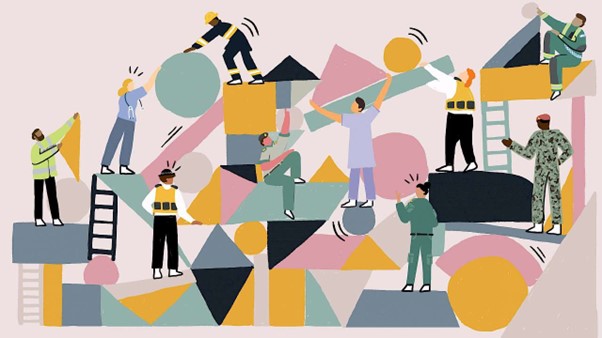You are here
- Home
- Blogs
- Anonymous's blog
- The enchantment of the hub and other (im)perfect integration solutions
The enchantment of the hub and other (im)perfect integration solutions
In a series of blogs over summer 2023, Dr Carol Jacklin-Jarvis and Dr Steven Parker from the Centre for Voluntary Sector Leadership reflect on current theory and practice for multi-agency collaboration.
In this second blog, Steve reflects on ‘The enchantment of the hub and other (im)perfect integration solutions’

ImageSource: Multi-Agency Emergency Response (crestresearch.ac.uk)
Is it possible to find the perfect integrated solution for multi-agency partners providing children’s services to deliver services together? This has been a core aspiration for children’s services providers for many years - indeed decades - going back to child protection inquiries from the 1940s (NSPCC 2023). Recommendations usually include aspirations for improved joint working and information sharing, and over time this has led to myriad changes to legislation, child focused policies and initiatives to improve joint working between different service providers.
Indeed, the broad aspiration to integrate services has intensified in recent decades, informed by the focus of partnership working during the Blair government, including Every Child Matters and Quality Protects policy: in some ways these were precursors to Sure Start and Children’s Centres in local communities (see Carol Jacklin’s CVSL blog, ‘Will collaboration for children work this time round?’ 9 May 2023). However, words that describe collaborative advantage remain confusing, are frequently open to interpretation, and need clearly defining by policy makers (Parker 2020).
Previously employed in local government children’s services, and researching multi-agency collaboration in my doctoral research, I have personally stumbled over the language of inter-agency and multi-agency working, networking, partnership governance, and more recently joint commissioning. Whilst working in social care strategy and planning, I was asked to turn blue sky strategic initiatives such as ‘one stop shops’ and ‘single points of access’ into clear and risk free pathways for citizens to access multi-agency services, whilst at the same time constructing a back space where the multi-agency machine would process referrals in a smooth, timely and risk free manner. Sounding plausible and easy to achieve when spoken aloud in a strategic partnership board, defining and implementing these projects was not for the faint hearted.
Recently, there has been increased usage of the word ‘hub’ as the latest integrating mechanism for shared services: family hubs (HMG 2022) multi agency safeguarding hubs (Shorrock et al. 2019); victims of crime hubs (Parker et al 2023); youth hubs (Simpson 2021), and so on. In its own way, the term hub implies an enhanced level of integration and communication, usually between multi-agency partners. As a policy metaphor (Lakoff and Johnstone 1980), the word hub also brings to mind a centre of operations, images of sanctuary, community, inclusion clarity and equality; leading to improved outcomes, wellbeing and social justice, alongside public and social value.
Within a policy context where we wish to do good, Dudau et al. (2019) have cautioned becoming enchanted by magic concepts which attempt to contain complexity within seemingly simple words. So, as we use the term hub, we should not forget that in our pursuit of (im)perfect integration there will be tensions between partners around organizational and information sharing. An example of this is the hub as new public governance (Osborne 2010) where a diversity of partners work within a framework of contractual arrangements and protocols, but where some partners hold more power, or may be excluded if there are too many partners (or who may not even choose to participate if they have insufficient resources to do so). Lastly, there is the hub as rationalization project, as austerity savings, co-location and open plan working. So, although the aspiration to integrate for societal value is the key rationale, there may well be other reasons for pursuing integration, with organizational imperfections arising after implementation (Sullivan and Williams 2012: Parker et al, 2023).
In conclusion, the words we use to describe multi-agency working do matter. In so many ways the latest term – hub - encapsulates what we want to achieve, but, like other terms, it can lure us into an over-simplified understanding of the realities of multi-agency collaboration. We must remain vigilant in our continuing search for improving shared services and (im)perfect integration. As an academic, and previously a social worker, my professional motivation remains the pursuit of improved multi-agency collaboration, but I am continually reflective about the ongoing desire to find the perfect solution.
References
Dudau, A., Glennon, R., and Verschuere, B. (2019). Following the yellow brick road? (Dis)enchantment with co-design, co-production and value co-creation in public services. Public Management Review, 21, 11, 1577–1594.
HMG (2022) Family Hubs and Start for Life programme guide. London, HMG.
Lakoff, G. and Johnson, M. (1980). Metaphors we live by. Chicago, The University of Chicago Press.
NSPCC (2023). History of child protection in the UK. London, NSPCC. Available at: https://learning.nspcc.org.uk/child-protection-system/history-of-child-protection-in-the-uk
Osborne, S. (2010) The new public governance. Abingdon: Routledge.
Parker, S. (2020). We must be clear about what we mean by shared services. Available at: https://www.cypnow.co.uk/other/article/we-must-be-clear-about-what-we-mean-by-shared-services
Parker, S., Hartley, J., Beashel, J., and Vo, Q. (2023). Leading for public value in multi-agency collaboration. Public Policy and Administration, 38, 1. 83-106.
Shorrock, S., McManus, M., Kirby, S. (2019). Investigating the characteristics of vulnerable referrals made to a multi-agency safeguarding hub. Policing: A Journal of Policy and Practice, 13,2, 201-212.
Simpson, F. (2021). DWP launches 110 Youth Employment Hubs. Children and Young People Now. Available at: https://www.cypnow.co.uk/news/article/dwp-launches-110-youth-employment-hubs
Sullivan, H. and Williams, P. (2012). Whose kettle? Exploring the role of objects in managing and mediating the boundaries of integration in health and social care. Journal of Health Organization and Management, 26, 6, 697-712.
12th June 2023


